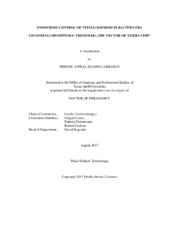| dc.contributor.advisor | Tamborindeguy, Cecilia | |
| dc.creator | Ibanez-Carrasco, Freddy Anibal | |
| dc.date.accessioned | 2018-02-05T21:20:16Z | |
| dc.date.available | 2019-08-01T06:52:17Z | |
| dc.date.created | 2017-08 | |
| dc.date.issued | 2017-07-26 | |
| dc.date.submitted | August 2017 | |
| dc.identifier.uri | https://hdl.handle.net/1969.1/166004 | |
| dc.description.abstract | The potato psyllid, Bactericera cockerelli (Šulc), is a phloem-feeding insect with preference for Solanaceae. This insect species transmits the pathogenic bacteria ‘Candidatus Liberibacter solanacearum’ (Lso) the causative agent of zebra chip, an important disease of commercial potatoes in several countries worldwide. The classification of psyllids among the most dangerous vectors has promoted their study, but still many biological processes need to be investigated. As a first step towards the elucidation of vitellogenesis in B. cockerelli, two candidate vitellogenin transcripts were identified and its expression was analyzed in different life stages. Our results showed that in virgin females, BcVg1-like expression increased up to 5 days old; while mating significantly upregulated its expression in 5- and 7-day-old females and also induced oviposition. BcVg6-like transcript was expressed at similar level between females and males and it was not up-regulated by mating. To elucidate the role of juvenile hormone in B. cockerelli Vgs expression, topical applications of juvenile hormone III (JH III) were performed on virgin females, resulting in an upregulation of BcVg1-like expression and an increase in the number of mature oocytes observed in female reproductive organs. While, BcVg6-like transcript did not showed changes in expression after exogenous application of JH III.
Presently five Lso-haplotypes have been identified worldwide; but only haplotypes A and B are associated with Bactericera cockerelli (Šulc.) in the Americas. Our results showed that no statistical differences in number of eggs oviposited and developing oocytes between Lso-free and LsoA-infected females. In contrast, a significant reduction in number of eggs laid and developing oocytes were observed in LsoB-infected mated females. Expression analyses showed that BcVg1-like and BcKr-h1 were highly expressed in Lso-free females after mating. A significant reduction in expression of BcVg1-like and BcKr-h1 was observed in LsoB mated females. While no changes were observed in the expression of S6 kinase, JH esterase and JH epoxide hydrolase across different ages.
Overall, this study represents the first step to understand the vitellogenesis and interaction of Lso with B. cockerelli, highlighting the function JH III in the hormonal regulation and the role BcVg1-like and BcKr-h1 in egg production and oocyte development. | en |
| dc.format.mimetype | application/pdf | |
| dc.language.iso | en | |
| dc.subject | Bactericera cockerelli | en |
| dc.subject | Vitellogenin | en |
| dc.subject | Juvenile hormone | en |
| dc.subject | Vitellogenesis | en |
| dc.subject | Psyllid | en |
| dc.subject | Reproduction | en |
| dc.subject | Candidatus Liberibacter solanacearum | en |
| dc.title | Endocrine Control of Vitellogenesis in Bactericera cockerelli (Hemiptera: Triozidae), the Vector of ‘Zebra Chip’ | en |
| dc.type | Thesis | en |
| thesis.degree.department | Entomology | en |
| thesis.degree.discipline | Entomology | en |
| thesis.degree.grantor | Texas A & M University | en |
| thesis.degree.name | Doctor of Philosophy | en |
| thesis.degree.level | Doctoral | en |
| dc.contributor.committeeMember | Carney, Ginger | |
| dc.contributor.committeeMember | Pietrantonio, Patricia | |
| dc.contributor.committeeMember | Coulson, Robert | |
| dc.type.material | text | en |
| dc.date.updated | 2018-02-05T21:20:17Z | |
| local.embargo.terms | 2019-08-01 | |
| local.etdauthor.orcid | 0000-0001-7085-3920 | |


